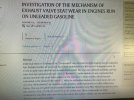FPK1
Line Up and Wait
"After an extensive trial, the University of North Dakota’s flight school has dropped Swift UL94 fuel and resumed use of 100LL. The school said ongoing maintenance monitoring of aircraft using UL94—almost exclusively Lycoming-powered Piper Archers and Seminoles—resulted in measurable exhaust valve recession. The school made the switch back to 100LL on Oct. 27."

 www.avweb.com
www.avweb.com

Citing Valve Damage, UND Drops Unleaded Fuel And Returns To 100LL (Updated)
UND ditches Swift Fuels UL94 after valve problems surface



